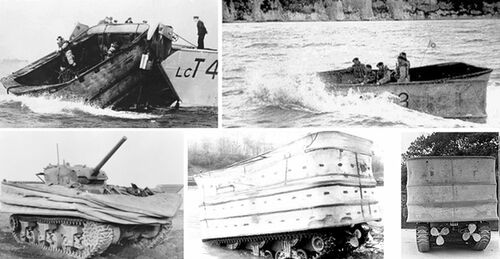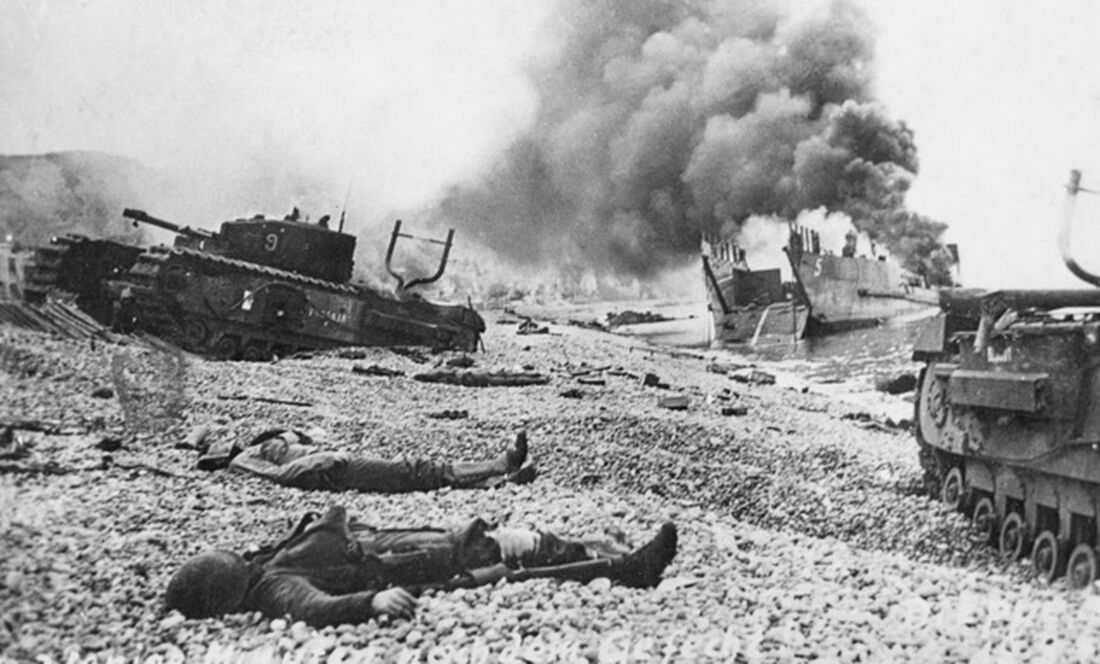Auction: 24001 - Orders, Decorations and Medals
Lot: 195
(x) An outstanding 'Operation Jubilee - Dieppe Raid 1942' M.M. group of seven awarded to Sergeant (Medical) G. E. Marchant, Essex Scottish, who was the stretcher bearer aboard LCT-4 on that legendary day, despite being under heavy fire at all times, he rose to the occasion and established a Dressing Station to tend the wounded and materially saved many lives and ensured as many as possible did not fall into enemy hands; a remarkable recording of his reminisces in 2010 gives his first-hand account
Military Medal, G.VI.R. (A.21531 Pte. G. E. Marchant. Essex Scot.), on its investiture pin; 1939-45 Star; France and Germany Star; Defence Medal 1939-45; Canadian Volunteer Service Medal 1939-45, with Overseas Service clasp; War Medal 1939-45, these last three Canadian issues in silver; Efficiency Medal, Canada (Sgt. G. E. Marchant, MM Essex Scot), this last with named box of issue, good very fine (7)
M.M. London Gazette 22 December 1942. The original recommendation states:
'Operation Jubilee - Dieppe Area - 19 August 1942
Pte. Marchant, stretcher bearer on LCT-4, was called upon to serve under constant fire throughout the day. Casualties were heavy when the craft was hit by MG, mortar and artillery fire, but Pte Marchant immediately organised a dressing station to look after the wounded.
Later he had them transferred to two launches and a destroyer. All this time, under heavy fire and dive bombing, he cheerfully worked at his task, rendering outstanding service and saving many lives.'
George Edmond Marchant - or Jim to his comrades and friends - was born in Fleet, Hampshire, in 1921. At the tender age of 17 he joined the Essex Scottish. The Canadian Government website gives more detail on his unit:
'In the 1860s, with the Fenians threatening Canada, the Windsor area of Ontario felt the need to establish an army for their protection. It wasn't until 12 June 1885, however, that the regiment, known as the 21st Essex Battalion of Infantry, was authorized. It was formed by the amalgamation of five infantry companies in the Windsor area. The Regiment went through a number of name changes before settling on the Essex Scottish Regiment on 15 July 1927.
On 1 September 1939, the Essex Scottish Regiment, C.A.S.F. was mobilized. Within only a few days the Regiment had recruited a full strength force, including a notable number of Americans.
On 16 August 1940 the Regiment set sail for England as part of the 2nd Canadian Infantry Division. It was two years later before they experienced their first fight, the Dieppe Raid, 19 August 1942, which left the Regiment almost completely decimated.'.
So it was, that Marchant would have carried the famous Clan Gregor tartan into action in August 1942, when the unit earned their first Battle Honour of the Second World War, also being in the first group of Canadian soldiers to serve in the European Theatre of Operations. Six Years of War - The Official Canadian History takes them ashore:
'The frontal attack on Dieppe was to be delivered by The Royal Hamilton Light Infantry on the right and the Essex Scottish on the left, with the nine leading tanks of the 14th Army Tank Regiment landing simultaneously with the first infantry. The assault was to be covered by the 4-inch guns of the destroyers and Locust; and close-support fighter aircraft were to attack the beaches, the buildings overlooking them and the gun positions on the West Headland "as the landing craft finallypproach and the first troops step ashore on RED and WHITE beaches". There was no hope of surprise here, for the flank landings were scheduled for half an hour earlier; and we have seen that the alarm was given in Dieppe, following the Pourville landing, 20 minutes before the main assault.
The R.H.L.I. and the Essex Scottish were carried across the Channel in the landing ships Glengyle, Prince Leopold and Prince Charles. The landing craft were lowered and made their approach without untoward incident, and the infantry units touched down on the long beach in front of Dieppe's Promenade - dedicated once to idleness and pleasure - at the exact time appointed or within a minute or two of it.
The naval orders called for intense direct bombardment by four destroyers and Locust from the time when the landing craft were one mile from the beach until they touched down. These were carried out, except that Locust did not participate; she had been unable to keep up during the passage. The Air Force also played its part precisely as planned. Smoke was laid to screen the East Headland; and at 5:15 a.m. five squadrons of Hurricane fighters made a cannon attack upon the beach defences. This was ending just as the Essex Scottish and The Royal Hamilton Light Infantry leaped from their assault craft and began to scramble through the wire obstacles towards the town. All witnesses agree that the Hurricane attack was excellently timed and most terrifying. It was planned to cease at 5:25, and its effect was of course purely temporary. Naval estimates of the time the first landing craft touched down vary from 5:20 to 5:23am...
On the Essex Scottish beach there was no such feature as the Casino to facilitate infiltration. It was completely open and was commanded by both headlands as well as by the high buildings in front. We have mentioned the French tank dug in near the base of the west mole; and on the mole itself there was a pillbox mounting an anti-tank gun. These two positions remained in German hands throughout the operation, though the enemy records that the one on the mole "suffered a direct hit", possibly from naval fire.
The only party of the Essex Scottish known to have got into the town was led by C. S. M. Cornelius Stapleton. Only a few minutes after the first landing, this stout Warrant Officer led a dozen or so men across the fire-swept Promenade into the buildings fronting the Boulevard de Verdun.
The party killed a number of enemy snipers in the buildings and subsequently penetrated through the streets to the harbour. It "accounted for a considerable number of enemy in transport and also enemy snipers"130 before being overpowered; its action is doubtless reflected in a German report logged at 8:16 a.m., that the enemy had been thrown back "from the harbour station (100 metres from the beach)". C. S. M. Stapleton got back to the beach and reported to Colonel Jasperson. In due course he received the Distinguished Conduct Medal.
Capt. D. F. MacRae, the only officer to land with the Essex Scottish who returned to England after the operation, recorded two attempts to attack across the sea-wall, followed by a third "on a reduced scale". These took place very soon after the landing and were beaten back by heavy fire. His estimate was that between 30 and 40 per cent of the Essex Scottish had been killed or wounded by 5:45 a.m. The estimate seems high, but it is clear that at an early stage the unit was, in MacRae's phrase, "unable to continue organized fighting" and was forced on to the defensive, using the line of the wall as a sort of fire-trench. "D" Company had had as one of its tasks the destruction of the Tobacco Factory, which was supposed to contain explosives. It fired grenades into the building, which from this or some other cause caught fire and burned fiercely.
From the time when the first momentum of the assault was lost, the situation on the beach remained largely static. The men of the R.H.L.I. and the Essex found what cover they could and tried to return the fire of a largely invisible enemy who continued to pour down bullets, mortar-bombs and shells. Casualties mounted steadily. Among those who laboured to assist the wounded during that sombre morning, one was particularly conspicuous: Honorary Captain J. W. Foote, Chaplain of the Hamilton regiment. He worked ceaselessly at giving first aid, and repeatedly exposed himself to carry injured men to the aid post. At the withdrawal, he helped bear the wounded to the boats but disdained to embark himself, choosing rather to continue his work of mercy as a prisoner. At the end of the war he received the Victoria Cross - the first ever awarded to a Canadian chaplain.'
Coming ashore with Flight 1A of the 14th Army Tank Regiment, this was the first unit of the Canadian Armoured Corps to go into action and the first occasion tanks would be landed against opposing fire. In LCT-4, Marchant would have seen her three Churchill tanks - Burns, Backer and Bolster - together with the Daimler Scout Helen land. Burns went straight up onto the promenade and over the ridge, when it was hit by a shell in the track, being knocked out and abandoned by the crew. Backer had been hit in the turret ring but got moving until also being immobilised in the left track. Bolster
thence made its charge, towing Helen, only to find the Scout destroyed by fire whilst in tow. The tank itself then ran aground on the beach. Like Backer, it continued to blaze away with fire until all its ammunition was expended. LCT-4 didn't fare much better, sinking when taking back to sea.
One cannot imagine the cool head displayed by Marchant during these most fierce moments, but it is clear he stood to his task and did all he could, materially saving lives and getting as many of the wounded off the beach and away to sea.
The Butcher's Bill for the Dieppe Raid is quite appalling. The Essex Scottish embarked 32 Officers and 521 other ranks. At the close of play, just 3 Officers and 49 other ranks returned to England. 6 Officers and 115 other ranks were fatal casualties, whilst 530 out of the 551 all ranks that had embarked were casualties.
Marchant was lucky to come away from the action at Dieppe with the M.M. to his name and continued to serve his unit during the remainder of the Second World War. They shared in the actions in Normandy, including the Battle of Verrières Ridge. Major Tiltson also won their only Victoria Cross for his gallantry in the Hochwald Forest, west of the Rhine River.
Returned to his native Essex, Ontario, Marchant for many years owned and operated West End Hardware, later working at Sears as a Department Manager until his retirement. He was a regular Church-goer and was also passionate about the care of injured birds. Having attended the Dieppe Memorial Service in August 2010, he died at the Iler Lodge Long Term Care Centre in September 2013 and by then was a grandfather eleven times over and a great-grandfather six times over.
Sold together with his War Service Badge Certificate, issued in March 1986, Essex Scottish shoulder titles and Essex & Kent Scottish lighter, this dated 1973.
A remarkable recording of George Marchant, talking of the Dieppe Raid, running to 42 minutes, is available via:
https://www.youtube.com/watch?v=8kN_xZ-hzq8
Subject to 5% tax on Hammer Price in addition to 20% VAT on Buyer’s Premium.
Sold for
£11,000
Starting price
£3500





















